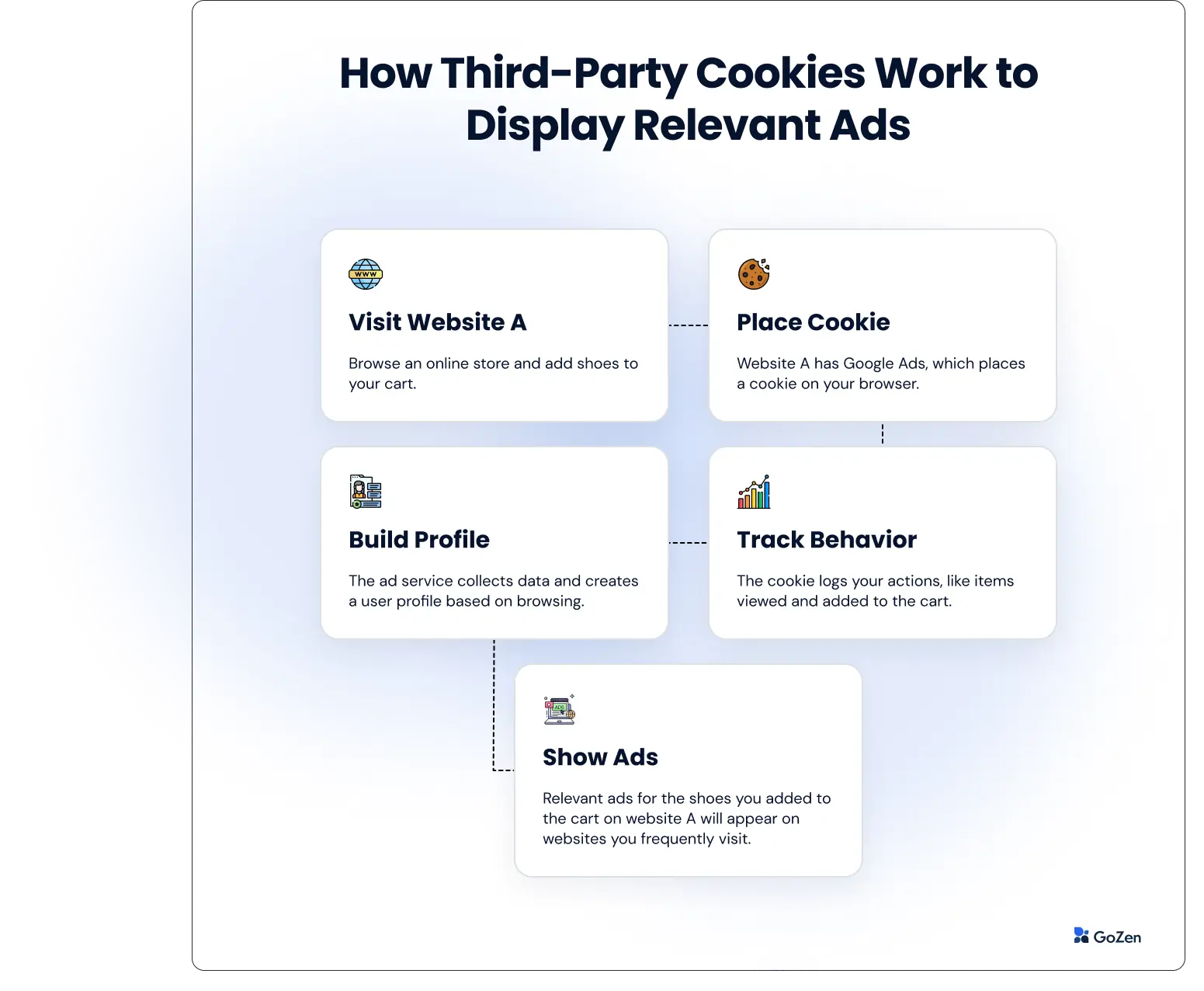Collecting zero-party data becomes essential as we move into a future without third-party cookies.
Zero-party data is information that customers willingly share with businesses, ensuring transparency and compliance with privacy laws.
Unlike third-party cookies, which gather data without consent, zero-party data respects user privacy and builds trust.
Table of Contents
What is a Third-Party Cookie?
Athird-party cookie is a small piece of data placed on your device by a domain other than the one you’re currently visiting.
These cookies track your online behavior across multiple websites, collecting data on:
The intention behind third-party cookies is to deliver personalized ads on the websites you frequently visit.
For example, if you add a product to your cart on an e-commerce website and then leave, you might see an ad for that product on another site the next day.
This happens because third-party cookies track your online behavior to serve personalized ads.
How Does a Third-Party Cookie Work?

Here’s a step-by-step explanation of how third-party cookies work to display relevant ads:
1. Visit Website A: You visit an online store (Website A), look at the products, and add shoes to your cart.
2. Placement of Third-Party Cookie: Website A has embedded content from a third-party advertising service (Google ads).
When the page loads, this service places a cookie on your browser.
3. Tracking User Behavior: The third-party cookie tracks your behavior, logging data such as items viewed and added to the cart.
4. Using the Behavioral Data: The advertising service collects this data and builds a profile based on your interactions and frequently visited web pages.
5. Targeted Advertising: The service displays ads relevant to your interests using this profile.
For example, browsing other websites, you may see ads for shoes you interacted with on Website A.
Why Google is Phasing Out Third-Party Cookies?
Google is phasing out third-party cookies to enhance user privacy and comply with global standards, like Europe’s GDPR and the U.S.’s CCPA, which demand higher standards for data collection and user consent.
The tech industry now understands that you’re in trouble if your service isn’t secure and privacy-focused.

Google’s Privacy Sandbox aims to balance personalization and ad measurement with user privacy, avoiding invasive tracking.
Other browsers, such as Apple Safari, Mozilla Firefox, Microsoft Edge, and Brave, have already blocked or provided options to block third-party cookies. Plus, there are tools to clear browser cache, cookies, and other temporary storage files.
Google Chrome’s complete phase-out of third-party cookies is now delayed until early 2025
Importance of Collecting Zero-Party Data in a Third-Party Cookie-Less Future
With third-party cookies becoming obsolete, zero-party data collection is essential.
Zero-party data is information that customers voluntarily share with businesses, ensuring transparency and compliance with privacy laws.
Unlike third-party cookies, which collect data without consent, zero-party data respects user privacy and builds trust.
Here are some reasons why collecting zero-party data is crucial:
1. High-Quality Data: Zero-party data is accurate and reliable because it comes directly from customers.
There’s less chance of receiving incorrect or incomplete information since customers willingly provide it.
2. Trust: Zero-party data comes from a place of trust. People sharing their information directly with brands shows they already trust them. This trust can lead to stronger customer relationships.
3. Consumer Intent: This data type is excellent for understanding what customers truly want.
It reveals their genuine interests and helps businesses know the most relevant products.
4. Personalization: Collecting zero-party data lets businesses get to know their customers better.
This leads to more personalized and meaningful experiences tailored to customers’ wants.
5. Transparency: The best part about zero-party data is its transparency. Customers know exactly what they’re sharing and how it will be used.
6. Compliance with Privacy Laws: With third-party cookies becoming obsolete, zero-party data is a smart alternative.
Zero-party data aligns perfectly with privacy laws, ensuring businesses stay compliant and responsible in their data collection practices.
Methods to Collect Zero-Party Data
Here are some methods through which you can collect zero-party data:
1. Surveys and Questionnaires: Ask customers for their opinions and preferences.
2. Quizzes: Create engaging quizzes that reveal customer preferences.
3. Polls: Use polls to gather quick insights.
4. Product Feedback Forms: Collect feedback on products and services.
5. Interactive Content: Use interactive content to engage users and gather data.
6. Personalized Email Preferences: Let customers choose their email preferences.
When customers sign up, offer options like “Get product news,” “Receive special offers,” “Find out about events,” and “Get weekly updates” to tailor email content to their interests.
7. Gated Content: Offer valuable content in exchange for customer information.
8. Contests and Giveaways: Use contests and giveaways to collect data.
9. Loyalty Programs: Encourage customers to share data in exchange for rewards.
10. Chatbots and Live Chats: Use chatbots to engage with customers and collect data.
11. Webinar Registrations: Collect data through webinar sign-ups.
12. Customer Account Sign-ups: Gather data when customers create accounts.
To effectively collect zero-party data, follow these steps:
1. Determine What Data You Need: Identify the specific data that will help improve your marketing, sales, and revenue.
2. Identify Data Sources: Decide where to collect the data.
Familiar sources include social media audiences, website visitors, email subscribers, and existing customers.
3. Choose Collection Methods: Select the best tools or platforms to collect data.
For example, GoZen Forms AI can help create user-friendly forms, surveys, quizzes, and polls without coding.
4. Prepare Your Data Collection Tools: Write down the questions you must ask, design the surveys and forms aesthetically appealing, and carefully order the questions to avoid biases.
5. Offer Value in Exchange for Data: People are likelier to share their data if they receive something valuable in return.
Example Values to Offer in Exchange for Data
6. Promote Your Data Collection Efforts Always mention the benefit your audience and customers can enjoy after sharing the data.
Your success in data collection depends upon the below factors,
1. Value Proposition: Ensure your value appeals to your target audience. You might think offering a reduced price will be appealing.
But the reality could be different,
Your target customers may need a solution to their frustrating problems, like how to do something and achieve Xresults.
It’s not what you think is best for them; it’s about what they actually want. Again, this is another great reason to collect zero-party data.
2. Effective Copywriting: How you write about your offer matters.
Like Vinh Giang, a communication skill coach, says, “Most of the time, how you say it matters more than what you say.”
3. Clarity: Be transparent about what data you are collecting and why. Avoid confusing your audience.
4. Design and User Experience: The design and usability of your forms and surveys impact the data quality you collect.
Use modern, visually appealing, and easy-to-use online forms - Like GoZen Forms AI
5. Avoid Overwhelming the Audience: Start small and use progressive profiling to gather more information over time.
Asking for too much information upfront can deter participation.
Zero-party data can also be destructive?
While zero-party data is valuable, it’s essential to recognize that people might give incorrect information due to biases.
To minimize this, design your surveys and feedback forms to reduce biases and gather accurate data that reflects true customer intentions and feelings.
Tools for Collecting Zero-Party Data
1. GoZen Forms AI: Create user-friendly and attractive online forms, surveys, quizzes, and polls without coding.
2. Optinly: Design conversion-focused pop-ups to collect email addresses and other data from website visitors.
3. GoZen Engage AI: Create interactive and gamified content with 1000+ templates to engage and gather data from your audience and customers.
Conclusion
While it’s important to collect zero-party data in a cookieless world, there are other data types you should care about collecting.
It can give you a complete picture of your target market and audience, resulting in more relevant and personalized marketing.
What’s your core problem in collecting zero-party data from your target audience?



